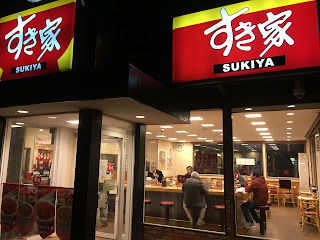Shiritori (しりとり=尻取り)is a popular Japanese word game where two or more players chain words - usually nouns - together. The literal meaning of "grabbing the buttocks" closely resembles its English equivalent "Grab on Behind" though which name came first is unclear! In the Japanese version, the
last syllable (a single vowel or consonant/vowel pair) of one word must be used as the
first syllable of the next word. For example, if one player says
terebi (television) the next player must say a word beginning with "bi" such as
bīru (beer). Saying a word ending in "n" such as
raion (lion) will end the game, causing that player to lose, since no Japanese words start with the Japanese syllable "n" (ん in
hiragana or ン in
katakana). Repeating words is not allowed. Different variations and local rules exist, such as choosing a specific theme (
e.g. animals), specifying a minimum length (
e.g. two or more syllables), or chanting in rhythm with a time limit. A silent variant (shown below)
is e-shiritori or picture-
shiritori which involves drawing pictures instead of saying the word. This is apparently popular amongst students since it can be quietly passed around during a boring class!
 |
| E (picture) shiritori: Can you get all the Japanese words? (answers below!) |
For Japanese language learners this can be a fun way to build vocabulary - see some kindergarten level quiz sheets
here - and also understand how the Japanese sound system itself works. In the first place, we can learn that Japanese syllables consist of one of five vowels (
aiueo) either alone (
i =stomach) or preceded by a consonant (
shi =poem) - the only exception is
n which was introduced above. The consonants are k/s/t/n/h/m/y/r/w and the Japanese alphabet lists syllables in the following order: a/i/u/e/u ka/ki/ku/ke/ko sa/shi/su/se/so
etc (the y and w lines are slight exceptions - see the
romanisation table here). An easy mnemonic to remember the alphabet order is "
Ah
Kana
Signs
Take
Note
How
Many
You
Read
Well."
Shiritori helps us notice that some Japanese consonants (specifically k/s/t/h) have voiced equivalents (g/z/d/b) and this is marked with a diacritic which looks a bit like a quotation mark called a
daku-ten : for example, "sa" (さ) becomes "za" (ざ). Another diacritic mark is the
han-daku-ten, a small circle which indicates half-voicing of the ha/he/fu/he/ho syllables: for example, "ho" (ほ) becomes "po" (ぽ). Thus, Japanese language learners (and keen blog readers) may have noticed that the second part of compound words in Japanse often becomes voiced (called
ren-daku): so for example
ori+kami (folding+paper) becomes
origami.
If you don't have a partner to play against, don't despiar:
hitori (one person)
shiritori is not uncommon; playing against an AI opponent
online is another option. One hint: not many words begin with "ru" in
Japanese, so one strategy is to think of words which end in this
syllable!












